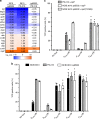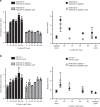A single mutation in rapP induces cheating to prevent cheating in Bacillus subtilis by minimizing public good production
- PMID: 30272012
- PMCID: PMC6123732
- DOI: 10.1038/s42003-018-0136-1
A single mutation in rapP induces cheating to prevent cheating in Bacillus subtilis by minimizing public good production
Abstract
Cooperation is beneficial to group behaviors like multicellularity, but is vulnerable to exploitation by cheaters. Here we analyze mechanisms that protect against exploitation of extracellular surfactin in swarms of Bacillus subtilis. Unexpectedly, the reference strain NCIB 3610 displays inherent resistance to surfactin-non-producing cheaters, while a different wild isolate is susceptible. We trace this interstrain difference down to a single amino acid change in the plasmid-borne regulator RapP, which is necessary and sufficient for cheater mitigation. This allele, prevalent in many Bacillus species, optimizes transcription of the surfactin operon to the minimum needed for full cooperation. When combined with a strain lacking rapP, NCIB 3610 acts as a cheater itself-except it does not harm the population at high proportions since it still produces enough surfactin. This strategy of minimal production is thus a doubly advantageous mechanism to limit exploitation of public goods, and is readily evolved from existing regulatory networks.
Conflict of interest statement
The authors declare no competing interests.
Figures





Similar articles
-
Bacillus subtilis Protects Public Goods by Extending Kin Discrimination to Closely Related Species.mBio. 2017 Jul 5;8(4):e00723-17. doi: 10.1128/mBio.00723-17. mBio. 2017. PMID: 28679746 Free PMC article.
-
Cheater-altruist synergy in public goods games.J Theor Biol. 2018 Oct 7;454:231-239. doi: 10.1016/j.jtbi.2018.06.012. Epub 2018 Jun 13. J Theor Biol. 2018. PMID: 29908187
-
Three non-aspartate amino acid mutations in the ComA Response regulator receiver motif severely decrease surfactin production, competence development and spore formation in Bacillus subtilis.J Microbiol Biotechnol. 2010 Feb;20(2):301-10. J Microbiol Biotechnol. 2010. PMID: 20208433
-
Concurrent coevolution of intra-organismal cheaters and resisters.J Evol Biol. 2015 Apr;28(4):756-65. doi: 10.1111/jeb.12618. Epub 2015 Mar 28. J Evol Biol. 2015. PMID: 25772340
-
The bright side of social cheaters: potential beneficial roles of "social cheaters" in microbial communities.FEMS Microbiol Ecol. 2020 Dec 30;97(1):fiaa239. doi: 10.1093/femsec/fiaa239. FEMS Microbiol Ecol. 2020. PMID: 33238304 Review.
Cited by
-
Experimental evolution of yeast shows that public-goods upregulation can evolve despite challenges from exploitative non-producers.Nat Commun. 2024 Sep 6;15(1):7810. doi: 10.1038/s41467-024-52043-9. Nat Commun. 2024. PMID: 39242624 Free PMC article.
-
Systems view of Bacillus subtilis pellicle development.NPJ Biofilms Microbiomes. 2022 Apr 12;8(1):25. doi: 10.1038/s41522-022-00293-0. NPJ Biofilms Microbiomes. 2022. PMID: 35414070 Free PMC article.
-
Kin discrimination drives territorial exclusion during Bacillus subtilis swarming and restrains exploitation of surfactin.ISME J. 2022 Mar;16(3):833-841. doi: 10.1038/s41396-021-01124-4. Epub 2021 Oct 14. ISME J. 2022. PMID: 34650232 Free PMC article.
-
Multiple and Overlapping Functions of Quorum Sensing Proteins for Cell Specialization in Bacillus Species.J Bacteriol. 2020 Apr 27;202(10):e00721-19. doi: 10.1128/JB.00721-19. Print 2020 Apr 27. J Bacteriol. 2020. PMID: 32071096 Free PMC article. Review.
-
Transcriptional Regulation and Mechanism of SigN (ZpdN), a pBS32-Encoded Sigma Factor in Bacillus subtilis.mBio. 2019 Sep 17;10(5):e01899-19. doi: 10.1128/mBio.01899-19. mBio. 2019. PMID: 31530675 Free PMC article.
References
-
- Amherd M, Velicer GJ, Rendueles O, Holman L. Spontaneous nongenetic variation of group size creates cheater-free groups of social microbes. Behav. Ecol. 2018;29:393–403. doi: 10.1093/beheco/arx184. - DOI
Grants and funding
LinkOut - more resources
Full Text Sources

